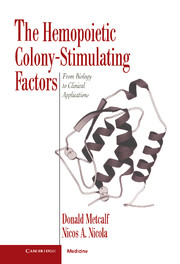Book contents
- Frontmatter
- Contents
- Preface
- 1 Historical introduction
- 2 General introduction to hemopoiesis
- 3 Key techniques in analyzing hemopoiesis
- 4 Biochemistry of the colony-stimulating factors
- 5 Biochemistry of the colony-stimulating factor receptors
- 6 Molecular genetics of the colony-stimulating factors and their receptors
- 7 Biological actions of the colony-stimulating factors in vitro
- 8 The biology of colony-stimulating factor production, degradation, and clearance
- 9 Actions of the colony-stimulating factors in vivo
- 10 Role of the colony-stimulating factors in basal hemopoiesis
- 11 Actions of the colony-stimulating factors in resistance to infections
- 12 Role of the colony-stimulating factors in other disease states
- 13 The colony-stimulating factors and myeloid leukemia
- 14 Clinical uses of the colony-stimulating factors
- 15 Conclusions
- References
- Index
10 - Role of the colony-stimulating factors in basal hemopoiesis
Published online by Cambridge University Press: 04 August 2010
- Frontmatter
- Contents
- Preface
- 1 Historical introduction
- 2 General introduction to hemopoiesis
- 3 Key techniques in analyzing hemopoiesis
- 4 Biochemistry of the colony-stimulating factors
- 5 Biochemistry of the colony-stimulating factor receptors
- 6 Molecular genetics of the colony-stimulating factors and their receptors
- 7 Biological actions of the colony-stimulating factors in vitro
- 8 The biology of colony-stimulating factor production, degradation, and clearance
- 9 Actions of the colony-stimulating factors in vivo
- 10 Role of the colony-stimulating factors in basal hemopoiesis
- 11 Actions of the colony-stimulating factors in resistance to infections
- 12 Role of the colony-stimulating factors in other disease states
- 13 The colony-stimulating factors and myeloid leukemia
- 14 Clinical uses of the colony-stimulating factors
- 15 Conclusions
- References
- Index
Summary
As noted in Chapter 8, early studies on the colony-stimulating factors documented that they are present in detectable amounts in the tissues and that their levels can rise dramatically in situations requiring an increased number of white cells. Subsequent work using the injection of recombinant CSFs in vivo certified their capacity to increase white cell production and function. While these data establish that the CSFs can regulate white cell production and function in vivo, they do not prove that the CSFs do function as important regulators of the basal production of these cells. The objection has been raised that levels of CSF in the serum or tissues of normal individuals are very low and become readily detectable only during infections. The argument has been advanced, therefore, that the CSFs might merely be “emergency” molecules, serving to enhance white cell production during infections, and that the production of basal levels of white cells in normal health is achieved by some other regulatory system.
Such criticisms can be countered in part by the fact that the CSFs are the strongest and most active stimuli for the formation of granulocytes and macrophages in vitro and by the data indicating that even when stromal cells support hemopoiesis, this process is associated with the production of CSFs by the stromal cells. Nevertheless, to prove formally that the CSFs are involved in the basal regulation of granulocyte and macrophage production, studies are required in which existing CSFs have been neutralized by the administration of antibodies or in which the various CSF genes have been inactivated.
- Type
- Chapter
- Information
- The Hemopoietic Colony-stimulating FactorsFrom Biology to Clinical Applications, pp. 205 - 210Publisher: Cambridge University PressPrint publication year: 1995



